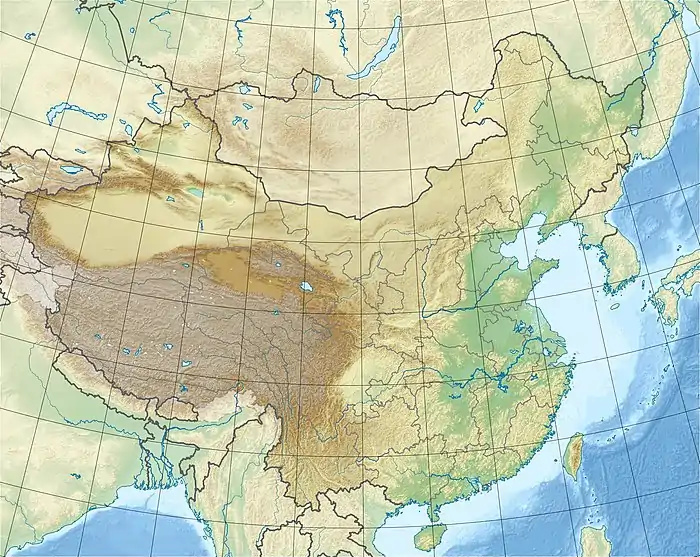Mount Tianzhu
Tianzhu Mountain or Mount Tianzhu (Chinese: 天柱山; pinyin: Tiānzhù Shān; lit. 'Heaven pillar mount') is a mountain in Anhui, China. Tianzhu Mountain is also called Mount Wan (Chinese: 皖山; pinyin: Wǎn Shān), from which the provincial abbreviation for Anhui ("Wan") derives. Ancient names of the mountain include Mount Huo 霍山, Mount Heng 衡山 (not to be confused with Mount Heng in Hunan Province), and Taiyue 太岳.
| Mount Tianzhu | |
|---|---|
.jpg.webp) Tianzhu Peak | |
| Highest point | |
| Elevation | 1,760 m (5,770 ft)[1] |
| Prominence | 1,642 m (5,387 ft)[1] |
| Listing | Ultra |
| Coordinates | 31°03′42″N 116°11′15″E[1] |
| Geography | |
 Mount Tianzhu Location in China | |
| Location | Anhui, China |
| Parent range | Shangdong Ranges |
The mountain is located in Qianshan County, Anqing City. Tianzhu Mountain has 45 peaks which are collectively 1000 meters above sea level. Its highest point has an elevation of 1,760 meters (5,774 ft). There are two paths to reach the top, either from the east or from the west; many will try the west path first because it is the easier one.
The mountain has natural landscapes such as spectacular peaks and rocks, secluded caves, and canyons.
One of the famous sites is the Mystery Valley (Chinese: 神秘谷; pinyin: Shénmì Gǔ). It is a maze-like valley formed by the rocks falling from the mountain. The valley has 53 caves, which form a very complicated maze.
Subsequently certified as a National Geopark, and then as a regional geopark (Asia Pacific Geopark Network), it was admitted as a UNESCO Global Geopark in 2011.
Climate
| Climate data for Mount Tianzhu (elevation 968 m (3,176 ft), (2007–2020 normals) | |||||||||||||
|---|---|---|---|---|---|---|---|---|---|---|---|---|---|
| Month | Jan | Feb | Mar | Apr | May | Jun | Jul | Aug | Sep | Oct | Nov | Dec | Year |
| Average high °C (°F) | 3.9 (39.0) |
6.6 (43.9) |
11.9 (53.4) |
17.4 (63.3) |
21.7 (71.1) |
23.6 (74.5) |
26.2 (79.2) |
26.5 (79.7) |
22.7 (72.9) |
18.0 (64.4) |
12.7 (54.9) |
6.6 (43.9) |
16.5 (61.7) |
| Daily mean °C (°F) | 0.3 (32.5) |
2.7 (36.9) |
7.5 (45.5) |
12.8 (55.0) |
17.4 (63.3) |
20.1 (68.2) |
22.8 (73.0) |
22.7 (72.9) |
18.8 (65.8) |
13.8 (56.8) |
8.5 (47.3) |
2.5 (36.5) |
12.5 (54.5) |
| Average low °C (°F) | −2.6 (27.3) |
−0.4 (31.3) |
3.9 (39.0) |
9.0 (48.2) |
13.8 (56.8) |
17.2 (63.0) |
20.5 (68.9) |
20.1 (68.2) |
15.9 (60.6) |
10.5 (50.9) |
5 (41) |
−0.7 (30.7) |
9.4 (48.8) |
| Average precipitation mm (inches) | 62.3 (2.45) |
89.4 (3.52) |
125.2 (4.93) |
163.6 (6.44) |
238.0 (9.37) |
315.8 (12.43) |
370.9 (14.60) |
225.6 (8.88) |
123.0 (4.84) |
79.5 (3.13) |
65.6 (2.58) |
45.9 (1.81) |
1,904.8 (74.98) |
| Average precipitation days (≥ 0.1 mm) | 12.3 | 13.2 | 14.0 | 13.5 | 14.3 | 16.0 | 16.2 | 15.1 | 11.6 | 11.0 | 11.5 | 9.1 | 157.8 |
| Average snowy days | 8.3 | 4.8 | 3.4 | 0.3 | 0 | 0 | 0 | 0 | 0 | 0 | 1.1 | 4.2 | 22.1 |
| Average relative humidity (%) | 72 | 76 | 73 | 72 | 76 | 87 | 90 | 88 | 83 | 74 | 71 | 65 | 77 |
| Mean monthly sunshine hours | 104.7 | 100.0 | 131.4 | 148.6 | 146.6 | 94.5 | 113.1 | 139.2 | 120.8 | 149.7 | 142.2 | 137.8 | 1,528.6 |
| Percent possible sunshine | 33 | 32 | 35 | 38 | 34 | 22 | 26 | 34 | 33 | 43 | 45 | 44 | 35 |
| Source: China Meteorological Administration[2][3] | |||||||||||||
References
- "China IV - Central and Eastern China, Taiwan and Korea". Peaklist.org. Retrieved 2011-10-03.
- 中国气象数据网 – WeatherBk Data (in Simplified Chinese). China Meteorological Administration. Retrieved 24 September 2023.
- 中国气象数据网 (in Simplified Chinese). China Meteorological Administration. Retrieved 24 September 2023.
External links
- Travel spots and tips in Anhui and other provinces
- A trip to the Mystery Valley
- "Tianzhu Shan" on Peakbagger